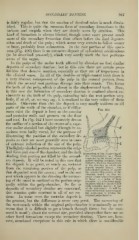Page 857 - My FlipBook
P. 857
SECONDARY DENTINE. 867
is fairly regular, but that the number of dentinal tubes is much dimin-
ished. This is quite the common form of secondary formations in the
incisors and cuspids when they are slowly worn by attrition. This
kind of formation is always limited, though some cases present much
more of the secondary formation than others before the final degener-
ation and death of the pulp ; which seems very certain to follow sooner
or later, probably from exhaustion. In the root portion of this speci-
men (Fig. 460) there is an extensive deposit of cylindrical calcifications
(to be described presently), which very surely mark the last perform-
ances of the organ.
In the pulps of the molar teeth affected by abrasion we find similar
deposits of secondary dentine ; but in this case there are certain pecu-
liarities that deserv^e mention, especially as they are of importance in
the clinical sense. In all of the double- or triple-rooted teeth there is
a very distinct enlargement of the pulp in the coronal portion, from
which the several root portions diverge into their canals. This forms
the bulb of the pulp, which is absent in the single-rooted teeth. Now,
in this case the formation of secondary dentine is confined almost ex-
clusively to the bulb of the pulp, extending into the root portion verv
little, if at all, or, we may say, it is confined to the very orifice of these
canals. Otherwise than this the deposit is very nearly uniform on all
parts of the walls of the chamber, or if differ-
ences exist the deposit is least on the anterior
and posterior walls and greatest on the floor
and roof. In Fig. 462 I have accurately drawn
the outline of a section of the crown of a supe-
rior molar abraded but slightly (though its as-
sociates were badly worn), for the purpose of
illustrating the position of the secondary de-
posits as they are most generally seen in cases
of extreme reduction of the size of the pulp.
The lightly-shaded portion represents the orig-
inal form and size of the chamber, and the dark
Illustration of the Narrowing of
shading that portion not filled by the second- the Pulp-chamber in a Slolar
(superior) by the deposit of sec-
ary deposit. It will be noted in this case that ondary dentine resulting from
aljrasion, showing the portions
the deposit is as great, or nearly so, rootwise
of the chamber in which the
deposit usually occurs. The
from the remaining portion of the pulp, as
light-shaded portion (li) shows
that dejjosited next the crown ; and in the one the original dimensions of the
chamber, which in this in-
root which appears in the drawing the narrow- stance seems to have been pret-
ty large ; a, a point of deep
ing of the canal is confined to the portion orig- abrasion ; c, c, remaining pulp-
inally within the pulp-chamber. So far as chamber, which is mostly filled
with irregular masses rf, one
;
deposits of secondary dentine are concerned, of the root-canals. It will be
observed that the narrowing of
this remains quite constant in all of my sec- the root-canal is within the
original pulp-chamber.
tions. In some cases the rootwise deposit is
the greatest, but the difference is never very great. The narrowing of
the root-canals within the original pulp-chamber is occasionally so ex-
treme that it is difficult to get a broach through them ; but the root-
canal is usually about the normal size, provided always that there are no
other hard formations except the secondary dentine. There arc, how-
ever, occasional exceptions to this rule in which there is considerable


